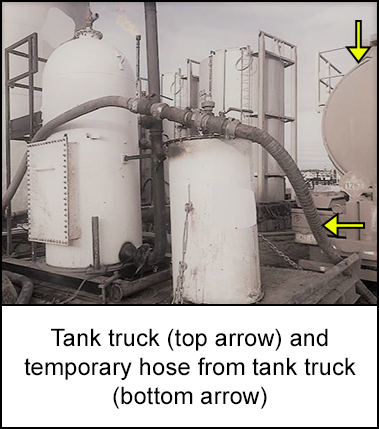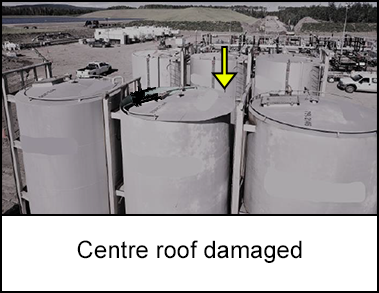-
What happened?
A chemical reaction took place in a sulphur scrubbing1 process that caused a thermal (heat) reaction. The sulphur scrubber was connected to aboveground storage tanks that contained hydrocarbons. A chemical reaction ignited the material in the tanks, causing the top of the tank to separate and lift from the structure.
Oxygen was introduced to the scrubber by fluids transferred from a tank truck creating a high temperature reaction in the scrubber. Under normal conditions, the sulphur scrubbing medium responds by a chemical reaction and removes H2S from hydrocarbons. If oxygen is present, the chemical by-product (iron sulphide) further responds by producing a thermal reaction. When temperatures exceed the autoignition point, a bed fire will occur.
1Scrubbing: One of several methods to remove toxic or corrosive compounds from hydrocarbons and neutralize it.

-
Why did it happen?
- Fire and explosion hazards caused by iron sulphide will spontaneously ignite when exposed to oxygen.
- Oxygen was introduced into the scrubber unit from the tank truck vent which contributed to the thermal reaction.
- Vent gas from the tank truck should not have been comingled into the scrubber and the aboveground storage tank. Engineering criteria for the scrubber unit did not include the addition of vent gas, and the operation and its hazards should have been re-assessed.
- When the scrubber unit began to heat up excessively, the process should have been shut down.
- Supplier did not make manufacturer’s equipment specifications for the harmful substance available to the supervisor.
Additionally, there were some contributing factors:
- Inadequate protective equipment on the scrubber unit, such as the use of a flame arrester and/or backflow device.
- Failure of a procedure or practice for additional vent gas inclusion to the scrubber.
- No safety data sheet (SDS) for the sulphur scrubbing medium.

-
What did they learn?
- Full hazard reviews with all affected personnel to be conducted before using chemical scrubber systems.
- Designate a scrubber system for storage tanks, refrain from comingling vent gases with those from other operations at the site.
- All scrubber units to have the safety data sheet (SDS) and safe operating procedures at each site.
- All SDSs will be reviewed and understood before operating the equipment.

-
Ask yourself or your crew
- What are the different types of vent gases that we come into contact with? What are the potential hazards associated with mixing vent gases from different operations?
- What are the proper procedures for shutting down a scrubber unit if it begins to heat up excessively?
- Do we have a procedure in place to prevent the mixing of vent gases from different operations and how do we know it is working? Do we have flame arresters or backflow devices on our scrubber units?
- Do we have a hazard review process in place for chemical scrubber systems?

Add to homescreen
Content name
Select existing category:
Content name
New collection
Edit collection
What happened?
A chemical reaction took place in a sulphur scrubbing1 process that caused a thermal (heat) reaction. The sulphur scrubber was connected to aboveground storage tanks that contained hydrocarbons. A chemical reaction ignited the material in the tanks, causing the top of the tank to separate and lift from the structure.
Oxygen was introduced to the scrubber by fluids transferred from a tank truck creating a high temperature reaction in the scrubber. Under normal conditions, the sulphur scrubbing medium responds by a chemical reaction and removes H2S from hydrocarbons. If oxygen is present, the chemical by-product (iron sulphide) further responds by producing a thermal reaction. When temperatures exceed the autoignition point, a bed fire will occur.
1Scrubbing: One of several methods to remove toxic or corrosive compounds from hydrocarbons and neutralize it.

Why did it happen?
- Fire and explosion hazards caused by iron sulphide will spontaneously ignite when exposed to oxygen.
- Oxygen was introduced into the scrubber unit from the tank truck vent which contributed to the thermal reaction.
- Vent gas from the tank truck should not have been comingled into the scrubber and the aboveground storage tank. Engineering criteria for the scrubber unit did not include the addition of vent gas, and the operation and its hazards should have been re-assessed.
- When the scrubber unit began to heat up excessively, the process should have been shut down.
- Supplier did not make manufacturer’s equipment specifications for the harmful substance available to the supervisor.
Additionally, there were some contributing factors:
- Inadequate protective equipment on the scrubber unit, such as the use of a flame arrester and/or backflow device.
- Failure of a procedure or practice for additional vent gas inclusion to the scrubber.
- No safety data sheet (SDS) for the sulphur scrubbing medium.

What did they learn?
- Full hazard reviews with all affected personnel to be conducted before using chemical scrubber systems.
- Designate a scrubber system for storage tanks, refrain from comingling vent gases with those from other operations at the site.
- All scrubber units to have the safety data sheet (SDS) and safe operating procedures at each site.
- All SDSs will be reviewed and understood before operating the equipment.
Ask yourself or your crew
- What are the different types of vent gases that we come into contact with? What are the potential hazards associated with mixing vent gases from different operations?
- What are the proper procedures for shutting down a scrubber unit if it begins to heat up excessively?
- Do we have a procedure in place to prevent the mixing of vent gases from different operations and how do we know it is working? Do we have flame arresters or backflow devices on our scrubber units?
- Do we have a hazard review process in place for chemical scrubber systems?
A chemical reaction took place in a sulphur scrubbing process that caused a thermal (heat) reaction. The sulphur scrubber was connected to aboveground storage tanks that contained hydrocarbons. A chemical reaction ignited the material in the tanks, causing the top of the tank to separate and lift from the structure.
Original material courtesy of Energy Safety Canada














